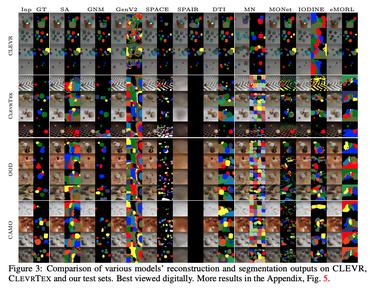Instance Segmentation
960 papers with code • 25 benchmarks • 82 datasets
Instance Segmentation is a computer vision task that involves identifying and separating individual objects within an image, including detecting the boundaries of each object and assigning a unique label to each object. The goal of instance segmentation is to produce a pixel-wise segmentation map of the image, where each pixel is assigned to a specific object instance.
Image Credit: Deep Occlusion-Aware Instance Segmentation with Overlapping BiLayers, CVPR'21
Libraries
Use these libraries to find Instance Segmentation models and implementationsDatasets
Subtasks
-
 Referring Expression Segmentation
Referring Expression Segmentation
-
 3D Instance Segmentation
3D Instance Segmentation
-
 Real-time Instance Segmentation
Real-time Instance Segmentation
-
 Unsupervised Object Segmentation
Unsupervised Object Segmentation
-
 Unsupervised Object Segmentation
Unsupervised Object Segmentation
-
 Amodal Instance Segmentation
Amodal Instance Segmentation
-
 Box-supervised Instance Segmentation
Box-supervised Instance Segmentation
-
 Image-level Supervised Instance Segmentation
Image-level Supervised Instance Segmentation
-
 Unseen Object Instance Segmentation
Unseen Object Instance Segmentation
-
 3D Semantic Instance Segmentation
3D Semantic Instance Segmentation
-
 Open-World Instance Segmentation
Open-World Instance Segmentation
-
 Human Instance Segmentation
Human Instance Segmentation
-
 One-Shot Instance Segmentation
One-Shot Instance Segmentation
-
 Semi-Supervised Person Instance Segmentation
Semi-Supervised Person Instance Segmentation
-
 Point-Supervised Instance Segmentation
Point-Supervised Instance Segmentation
-
 Solar Cell Segmentation
Solar Cell Segmentation
Most implemented papers
Non-local Neural Networks
Both convolutional and recurrent operations are building blocks that process one local neighborhood at a time.
SOLO: Segmenting Objects by Locations
We present a new, embarrassingly simple approach to instance segmentation in images.
Deformable ConvNets v2: More Deformable, Better Results
The superior performance of Deformable Convolutional Networks arises from its ability to adapt to the geometric variations of objects.
Towards End-to-End Lane Detection: an Instance Segmentation Approach
By doing so, we ensure a lane fitting which is robust against road plane changes, unlike existing approaches that rely on a fixed, pre-defined transformation.
High-Resolution Image Synthesis and Semantic Manipulation with Conditional GANs
We present a new method for synthesizing high-resolution photo-realistic images from semantic label maps using conditional generative adversarial networks (conditional GANs).
Swin Transformer V2: Scaling Up Capacity and Resolution
Three main techniques are proposed: 1) a residual-post-norm method combined with cosine attention to improve training stability; 2) A log-spaced continuous position bias method to effectively transfer models pre-trained using low-resolution images to downstream tasks with high-resolution inputs; 3) A self-supervised pre-training method, SimMIM, to reduce the needs of vast labeled images.
SOLOv2: Dynamic and Fast Instance Segmentation
Importantly, we take one step further by dynamically learning the mask head of the object segmenter such that the mask head is conditioned on the location.
Visual Attention Network
In this paper, we propose a novel linear attention named large kernel attention (LKA) to enable self-adaptive and long-range correlations in self-attention while avoiding its shortcomings.
Multi-Task Learning Using Uncertainty to Weigh Losses for Scene Geometry and Semantics
Numerous deep learning applications benefit from multi-task learning with multiple regression and classification objectives.
PointRend: Image Segmentation as Rendering
We present a new method for efficient high-quality image segmentation of objects and scenes.


























 MS COCO
MS COCO
 Cityscapes
Cityscapes
 nuScenes
nuScenes
 ADE20K
ADE20K
 NYUv2
NYUv2
 LVIS
LVIS
 BDD100K
BDD100K
 KITTI-360
KITTI-360
 YouTube-VIS 2019
YouTube-VIS 2019
 Objects365
Objects365


